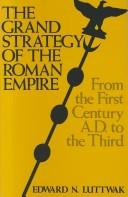Check nearby libraries
Buy this book

At the height of its power, the Roman Empire encompassed the entire Mediterranean basin, extending much beyond it from Britain to Mesopotamia, from the Rhine to the Black Sea. Rome prospered for centuries while successfully resisting attack, fending off everything from overnight robbery raids to full-scale invasion attempts by entire nations on the move. How were troops able to defend the Empire’s vast territories from constant attacks? And how did they do so at such moderate cost that their treasury could pay for an immensity of highways, aqueducts, amphitheaters, city baths, and magnificent temples?
In The Grand Strategy of the Roman Empire, seasoned defense analyst Edward N. Luttwak reveals how the Romans were able to combine military strength, diplomacy, and fortifications to effectively respond to changing threats. Rome’s secret was not ceaseless fighting, but comprehensive strategies that unified force, diplomacy, and an immense infrastructure of roads, forts, walls, and barriers. Initially relying on client states to buffer attacks, Rome moved to a permanent frontier defense around 117 CE. Finally, as barbarians began to penetrate the empire, Rome filed large armies in a strategy of "defense-in-depth," allowing invaders to pierce Rome’s borders. [Excerpted from Amazon.com description of the revised and updated edition]
In effect, The Grand Strategy of the Roman Empire ran out of time and money. The Grand Strategy, successful for hundreds of years, relied heavily on persuading "barbarian" tribes to join the Roman system for the commercial and security benefits. This process of integration worked because it was backed by the threat of destruction by military force.
The Empire maintained relatively modest military forces given its vast territory, but its road system and fleet enabled relatively rapid concentration of force to counter an invasion. It also maintained extensive fortifications along active borders.
All of this required substantial tax revenues, manpower and effective leadership, not just for fortifications, the army, roads and the fleet, but to maintain the commercial and political benefits offered to "barbarians" who chose integration in the Empire.
Once the military threats proliferated and the benefits of Imperial membership eroded, the Grand Strategy was unable to maintain the integrity of the Imperial borders.
As tax revenues and the bureaucracy they supported imploded, security declined, reducing trade and communications. This unvirtuous cycle fed on itself: reduced trade led to reduced tax revenues which led to phantom legions that were still listed on the bureaucratic ledgers but which no longer had any troops. [Charles Hugh-Smith commentary
Check nearby libraries
Buy this book

Previews available in: English
| Edition | Availability |
|---|---|
|
1
The grand strategy of the Roman Empire from the first century A.D. to the third
1976, Johns Hopkins University Press
in English
080181863X 9780801818639
|
aaaa
|
Book Details
Edition Notes
Bibliography: p. 233-246.
Includes index.
Classifications
The Physical Object
ID Numbers
Source records
Scriblio MARC recordIthaca College Library MARC record
University of Prince Edward Island MARC record
Internet Archive item record
marc_openlibraries_phillipsacademy MARC record
marc_openlibraries_sanfranciscopubliclibrary MARC record
Library of Congress MARC record
Internet Archive item record
marc_gtu MARC record
Better World Books record
harvard_bibliographic_metadata record
ISBNdb
marc_columbia MARC record
Community Reviews (0)
Feedback?| July 22, 2024 | Edited by MARC Bot | import existing book |
| June 17, 2022 | Edited by ImportBot | import existing book |
| January 26, 2022 | Edited by ImportBot | import existing book |
| February 14, 2020 | Edited by MARC Bot | remove fake subjects |
| December 9, 2009 | Created by WorkBot | add works page |














